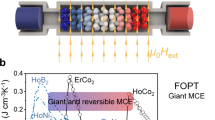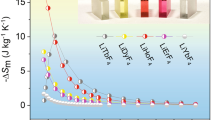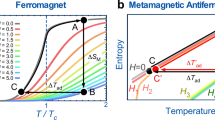Abstract
The giant magnetocaloric effect, in which large thermal changes are induced in a material on the application of a magnetic field, can be used for refrigeration applications, such as the cooling of systems from a small to a relatively large scale. However, commercial uptake is limited. We propose an approach to magnetic cooling that rejects the conventional idea that the hysteresis inherent in magnetostructural phase-change materials must be minimized to maximize the reversible magnetocaloric effect. Instead, we introduce a second stimulus, uniaxial stress, so that we can exploit the hysteresis. This allows us to lock-in the ferromagnetic phase as the magnetizing field is removed, which drastically removes the volume of the magnetic field source and so reduces the amount of expensive Nd–Fe–B permanent magnets needed for a magnetic refrigerator. In addition, the mass ratio between the magnetocaloric material and the permanent magnet can be increased, which allows scaling of the cooling power of a device simply by increasing the refrigerant body. The technical feasibility of this hysteresis-positive approach is demonstrated using Ni–Mn–In Heusler alloys. Our study could lead to an enhanced usage of the giant magnetocaloric effect in commercial applications.
This is a preview of subscription content, access via your institution
Access options
Access Nature and 54 other Nature Portfolio journals
Get Nature+, our best-value online-access subscription
$29.99 / 30 days
cancel any time
Subscribe to this journal
Receive 12 print issues and online access
$259.00 per year
only $21.58 per issue
Buy this article
- Purchase on Springer Link
- Instant access to full article PDF
Prices may be subject to local taxes which are calculated during checkout




Similar content being viewed by others
Data availability
The data that support the findings of this study are available from the corresponding authors upon reasonable request.
References
Belman-Flores, J. M., Barroso-Maldonado, J. M., Rodríguez-Muñoz, A. P. & Camacho-Vázquez, G. Enhancements in domestic refrigeration, approaching a sustainable refrigerator— review. Renew. Sust. Energ. Rev. 51, 955–968 (2015).
Gutfleisch, O. et al. Magnetic materials and devices for the 21st century: stronger, lighter, and more energy efficient. Adv. Mater. 23, 821–842 (2011).
Sandeman, K. G. Magnetocaloric materials: the search for new systems. Scripta Mater. 67, 566–571 (2012).
Moya, X., Kar-Narayan, S. & Mathur, N. D. Caloric materials near ferroic phase transitions. Nat. Mater. 13, 439–450 (2014).
Takeuchi, I. & Sandeman, K. Solid-state cooling with caloric materials. Phys. Today 68, 48–54 (December, 2015).
Krenke, T. et al. Inverse magnetocaloric effect in ferromagnetic Ni–Mn–Sn alloys. Nat. Mater. 4, 450–454 (2005).
Liu, J., Gottschall, T., Skokov, K. P., Moore, J. D. & Gutfleisch, O. Giant magnetocaloric effect driven by structural transitions. Nat. Mater. 11, 620–626 (2012).
Mañosa, L. et al. Giant solid-state barocaloric effect in the Ni–Mn–In magnetic shape-memory alloy. Nat. Mater. 9, 478–481 (2010).
Matsunami, D., Fujita, A., Takenaka, K. & Kano, M. Giant barocaloric effect enhanced by the frustration of the antiferromagnetic phase in Mn3GaN. Nat. Mater. 14, 73–78 (2015).
Bonnot, E., Romero, R., Mañosa, L., Vives, E. & Planes, A. Elastocaloric effect associated with the martensitic transition in shape-memory alloys. Phys. Rev. Lett. 100, 125901 (2008).
Tušek, J. et al. The elastocaloric effect: a way to cool efficiently. Adv. Energy Mater. 5, 1500361 (2015).
Smith, A. et al. Materials challenges for high performance magnetocaloric refrigeration devices. Adv. Eng. Mater. 2, 1288–1318 (2012).
Scarpa, F., Tagliafico, G. & Tagliafico, L. A. A classification methodology applied to existing room temperature magnetic refrigerators up to the year 2014. Renew. Sust. Energ. Rev. 50, 497–503 (2015).
Kitanovski, A., Plaznik, U., Tomc, U. & Poredoš, A. Present and future caloric refrigeration and heat-pump technologies. Int. J. Refrig. 57, 288–298 (2015).
Yu, B., Liu, M., Egolf, P. W. & Kitanovski, A. A review of magnetic refrigerator and heat pump prototypes built before the year 2010. Int. J. Refrig. 33, 1029–1060 (2010).
Gómez, J. R., Garcia, R. F., Catoira, A. D. M. & Gómez, M. R. Magnetocaloric effect: a review of the thermodynamic cycles in magnetic refrigeration. Renew. Sust. Energ. Rev. 17, 74–82 (2013).
Engelbrecht, K. et al. Experimental results for a novel rotary active magnetic regenerator. Int. J. Refrig. 35, 1498–1505 (2012).
Zimm, C. et al. Design and performance of a permanent-magnet rotary refrigerator. Int. J. Refrig. 29, 1302–1306 (2006).
Bjørk, R., Smith, A., Bahl, C. & Pryds, N. Determining the minimum mass and cost of a magnetic refrigerator. Int. J. Refrig. 34, 1805–1816 (2011).
Monfared, B., Furberg, R. & Palm, B. Magnetic vs. vapor-compression household refrigerators: A preliminary comparative life cycle assessment. Int. J. Refrig. 42, 69–76 (2014).
Gottschall, T., Skokov, K. P. & Gutfleisch, O. Kühlvorrichtung und ein Verfahren zum Kühlen. German patent 10 2016 110, 385.3 (2016).
Gottschall, T. et al. A matter of size and stress: understanding the first-order transition in materials for solid-state refrigeration. Adv. Funct. Mater. 27, 1606735 (2017).
Mañosa, L. et al. Inverse barocaloric effect in the giant magnetocaloric La–Fe–Si–Co compound. Nat. Commun. 2, 595 (2011).
Gutfleisch, O. et al. Mastering hysteresis in magnetocaloric materials. Phil. Trans. R. Soc. A 374, 20150308 (2016).
Song, Y., Chen, X., Dabade, V., Shield, T. W. & James, R. D. Enhanced reversibility and unusual microstructure of a phase-transforming material. Nature 502, 85–88 (2013).
Gottschall, T., Skokov, K. P., Benke, D., Gruner, M. E. & Gutfleisch, O. Contradictory role of the magnetic contribution in inverse magnetocaloric Heusler materials. Phys. Rev. B 93, 184431 (2016).
Pérez-Reche, F. J., Vives, E., Mañosa, L. & Planes, A. Athermal character of structural phase transitions. Phys. Rev. Lett. 87, 195701 (2001).
Karaca, H. E. et al. Magnetic field-induced phase transformation in NiMnCoIn magnetic shape-memory alloys—a new actuation mechanism with large work output. Adv. Funct. Mater. 19, 983–998 (2009).
Gottschall, T., Skokov, K. P., Frincu, B. & Gutfleisch, O. Large reversible magnetocaloric effect in Ni–Mn–In–Co. Appl. Phys. Lett. 106, 021901 (2015).
Gottschall, T. et al. Reversibility of minor hysteresis loops in magnetocaloric Heusler alloys. Appl. Phys. Lett. 110, 223904 (2017).
Chirkova, A. et al. Giant adiabatic temperature change in FeRh alloys evidenced by direct measurements under cyclic conditions. Acta Mater. 106, 15–21 (2016).
Acknowledgements
The work was supported by funding from the European Research Council (ERC) under the European Union’s Horizon 2020 research and innovation programme (grant no. 743116—project Cool Innov), the DFG (grant no. SPP 1599), the CICyT (Spain) project MAT2016-75823-R and the HLD at HZDR, a member of the European Magnetic Field Laboratory.
Author information
Authors and Affiliations
Contributions
T.G., M.F., A.T., L.P. and K.P.S. were responsible for the sample preparation. T.G., A.G.-C., A.P. and L.M. designed and performed the tensile test and cycling experiments. A.T., M.F. and K.P.S. took care of the adiabatic temperature-change measurements and microscopy. All the authors discussed the results and developed the explanation of the experiments. T.G. wrote the manuscript supported by all the co-authors. O.G. led the project.
Corresponding authors
Ethics declarations
Competing interests
The authors declare no competing interests.
Additional information
Publisher’s note: Springer Nature remains neutral with regard to jurisdictional claims in published maps and institutional affiliations.
Supplementary information
Supplementary Information
Supplementary Figures 1–8, Supplementary References 1–2
Rights and permissions
About this article
Cite this article
Gottschall, T., Gràcia-Condal, A., Fries, M. et al. A multicaloric cooling cycle that exploits thermal hysteresis. Nature Mater 17, 929–934 (2018). https://doi.org/10.1038/s41563-018-0166-6
Received:
Accepted:
Published:
Issue Date:
DOI: https://doi.org/10.1038/s41563-018-0166-6
This article is cited by
-
Effect of Electron Irradiation on Electronic Structure of Ni41Co6Mn43Sn10 Alloys
Electronic Materials Letters (2024)
-
Proposed Compositions in a Ni-Mn-Ga System for Magnetocaloric Applications
Journal of Electronic Materials (2024)
-
Elastocaloric Effect in Shape-Memory Alloys
Shape Memory and Superelasticity (2024)
-
Giant low-field magnetocaloric effect of (Er,Y)Cr2Si2 compounds at ultra-low temperatures
Science China Materials (2023)
-
Magnetic Properties and Enhanced Magneto-Caloric Performances by Zn Substitution in the Dy2BaCu1−xZnxO5 (x = 0.25, 0.5, 0.75) Oxides
Journal of Electronic Materials (2023)



